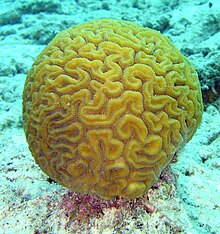Diploria
| Diploria | |
|---|---|

| |
| Scientific classification | |
| Kingdom: | Animalia |
| Phylum: | Cnidaria |
| Class: | Hexacorallia |
| Order: | Scleractinia |
| Family: | Mussidae |
| Genus: | Diploria Milne-Edwards and Haime, 1848 |
| Species: | D. labyrinthiformis
|
| Binomial name | |
| Diploria labyrinthiformis (Linnaeus, 1758)[2]
| |
| Synonyms | |
|
List (Species)
| |
Diploria is a monotypic genus of massive reef building stony corals in the family Mussidae.[3][4][5][6] It is represented by a single species, Diploria labyrinthiformis, commonly known as grooved brain coral and is found in the western Atlantic Ocean and Caribbean Sea.[7][2][8][9] It has a familiar, maze-like appearance.
Description[]

This species of reef-building coral has a hemispherical, brain-like shape with a brown, yellow, or grey colour.[8] It has characteristic deep, interconnected double-valleys. These polyp-bearing valleys are each separated by grooved ambulacral ridges. There may be a difference in colour between the valleys and the grooves.[10]
Diploria labyrinthiformis can grow upward at a rate of approximately 3.5 millimeters per year, achieving about 2 metres (6.6 feet) in diameter. During its planktonic larval stage, the coral has locomotion. After that time, it becomes permanently sessile.[11]
This species is a suspension feeder, and survives mainly on zooplankton and bacteria. These are captured by the polyps, by extruding mesenterial filaments and tentacles. The polyps have nematocysts which are triggered to hold their prey immobile. The prey is then transported to the mouth with the assistance of mucus and cilia.[11]
Diploria labyrinthiformis is hermaphroditic, and reproduces through broadcast spawning. This entails eggs and sperm being released by adult colonies, followed by fertilization and the development of larvae at the water surface. Unlike most other Caribbean broadcast spawners, Diploria labyrinthiformis spawns over multiple months from the late spring until even mid-autumn.[12]
Distribution and habitat[]
Diploria labyrinthiformis is found in tropical parts of the west Atlantic Ocean, the Gulf of Mexico, the Caribbean Sea, the southern tip of Florida, the Bahamas, Bermuda and the coasts of Central America.[1][2][13]
This coral occurs offshore at depths ranging from 1 to 30 metres (3.3 to 98.4 feet).[11]
Relationships with other species[]
Symbiotic[]
Diploria labyrinthiformis hosts Zooxanthella, a symbiotic dinoflagellate alga. The alga benefits from being in a protective environment in an elevated position. The coral benefits from the nutrients produced photosynthetically by the alga which provides part of its needs for growth and calcification.[11]
The coral also has a relationship with Diadema antillarum, the long-spined urchin, whose grazing helps to reduce the effects of shading, as well as the overgrowth of macroalgae.[11]
Predators[]
Despite the polyps being equipped with nematocysts, various species prey upon Diploria labyrinthiformis. These include:[11]
- Gastropods
- Polychaetes (annelid worms)
- Sea urchins
- Starfishes
- Sea spiders
- Parrotfish and other fishes
Parasites[]
This species is host to a parasite in the Corallovexiidae family:[2]
- is both an ectoparasite and an endoparasite.

Postage stamps[]
Images of Diploria labyrinthiformis appear on three postage stamps: a 75 cent Belizean stamp created by ,[14] a 15 cent stamp from United States issued 1980-08-26 and a 54 Euro cent stamp from Mayotte.[15]
See also[]
- Brain coral
- Colpophyllia natans (large-grooved brain coral)
References[]
- ^ a b Aronson, R.; Bruckner, A.; Moore, J.; Precht, B.; E. Weil (2008). "Diploria labyrinthiformis". IUCN Red List of Threatened Species. 2008: e.T133257A3657726. doi:10.2305/IUCN.UK.2008.RLTS.T133257A3657726.en. Retrieved 19 November 2021.
- ^ a b c d "WoRMS - World Register of Marine Species - Diploria labyrinthiformis (Linnaeus, 1758)". Marinespecies.org. Retrieved 2018-08-12.
- ^ Grooved Brain Coral, Diploria labyrinthiformis. Retrieved 2011-12-25.
- ^ Coralpedia - Diploria labyrinthiformis. Retrieved 2011-12-25.
- ^ Diploria labyrinthiformis (grooved brain coral) | Natural History Museum. Retrieved 2011-12-25.
- ^ Marine Species Identification Portal : Grooved brain coral - Diploria labyrinthiformis. Retrieved 2011-12-25.
- ^ "WoRMS - World Register of Marine Species - Diploria labyrinthiformis (Linnaeus, 1758)". www.marinespecies.org. Retrieved 2018-08-13.
- ^ a b "Marine Species Identification Portal : Grooved brain coral - Diploria labyrinthiformis". Species-identification.org. Retrieved 2011-12-19.
- ^ "Diploria labyrinthiformis (grooved brain coral) | Natural History Museum". Nhm.ac.uk. Retrieved 2011-12-19.
- ^ "Coralpedia - Diploria labyrinthiformis". Coralpedia.bio.warwick.ac.uk. Retrieved 2011-12-19.
- ^ a b c d e f Kate Rossi-Snook & Dr. James B. Wood. "Grooved Brain Coral, Diploria labyrinthiformis". Thecephalopodpage.org. Retrieved 2011-12-19.
- ^ Chamberland, V.F. (2017). "The reproductive biology and early life ecology of a common Caribbean brain coral, Diploria labyrinthiformis (Scleractinia: Faviinae)" (PDF). Coral Reefs. 36 (1): 83–94. doi:10.1007/s00338-016-1504-2.
- ^ Diploria labyrinthiformis Corals of the World. accessdate=2011-12-26
- ^ "WoRMS - World Register of Marine Species". Marinespecies.org. 2008-11-07. Retrieved 2011-12-19.
- ^ "WoRMS - World Register of Marine Species". Marinespecies.org. 2011-11-01. Retrieved 2011-12-19.
External links[]
| Wikimedia Commons has media related to Diploria. |
| Wikispecies has information related to Diploria. |
- IUCN Red List least concern species
- Faviinae
- Corals described in 1758
- Taxa named by Carl Linnaeus
- Taxa named by Henri Milne-Edwards
- Taxa named by Jules Haime
- Scleractinia genera

